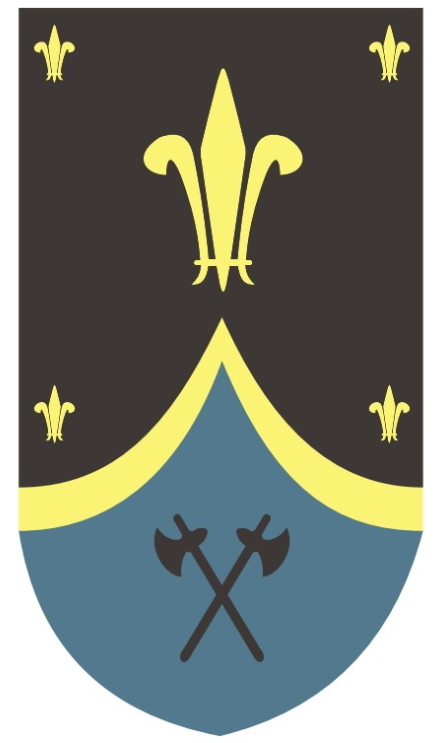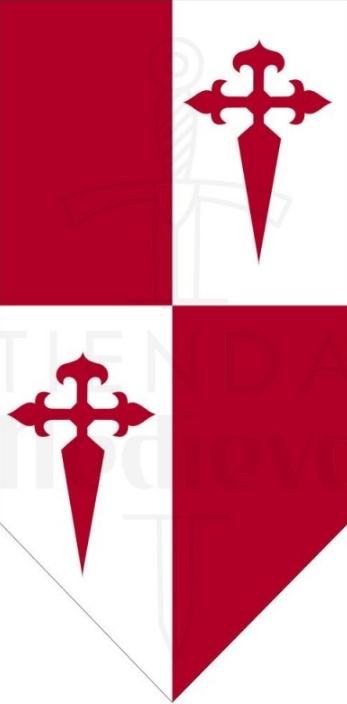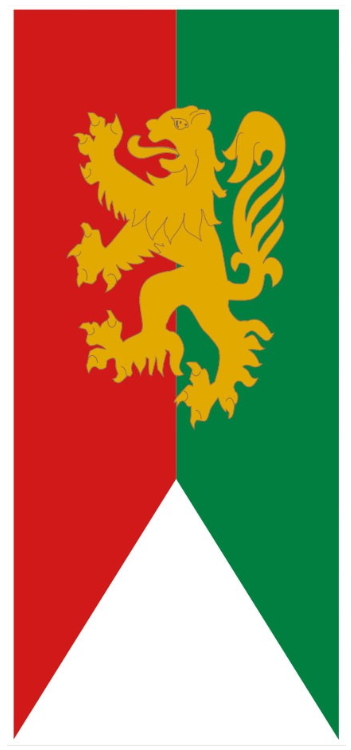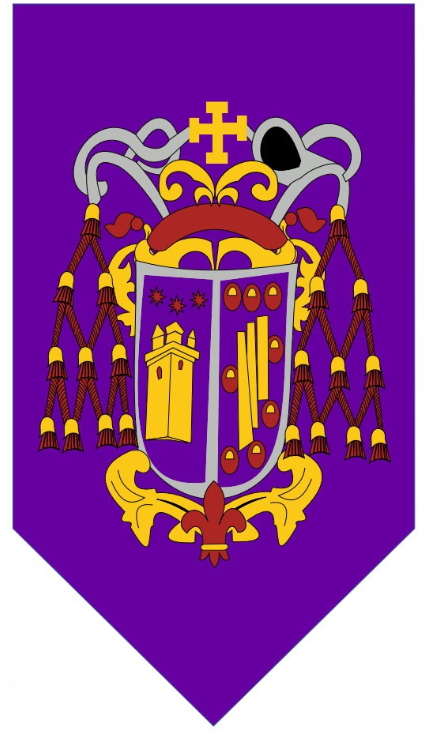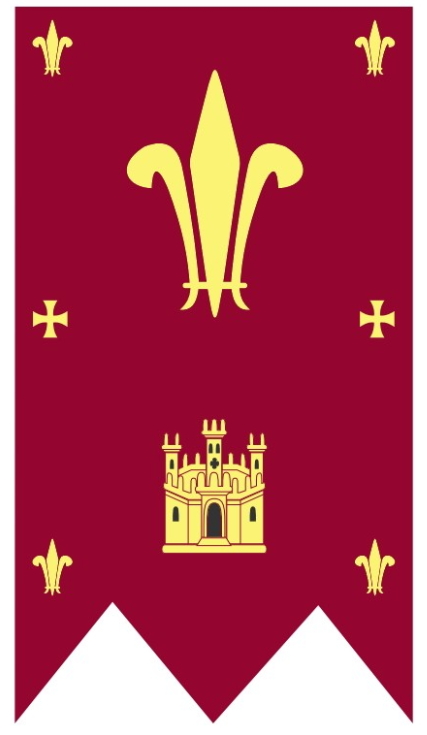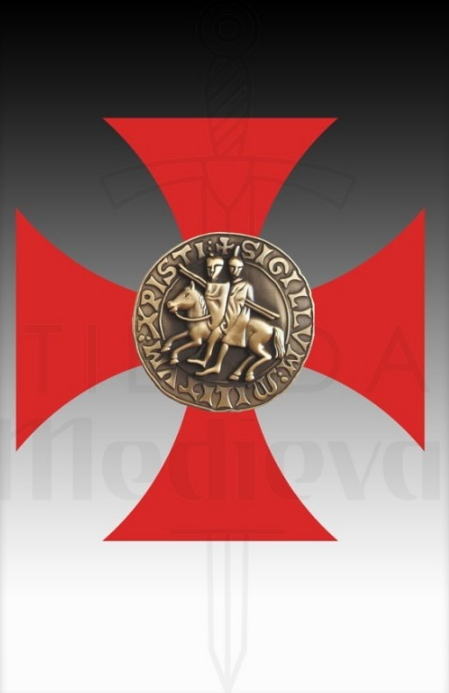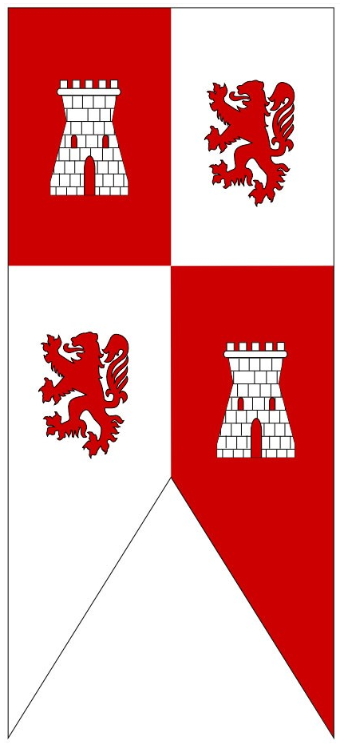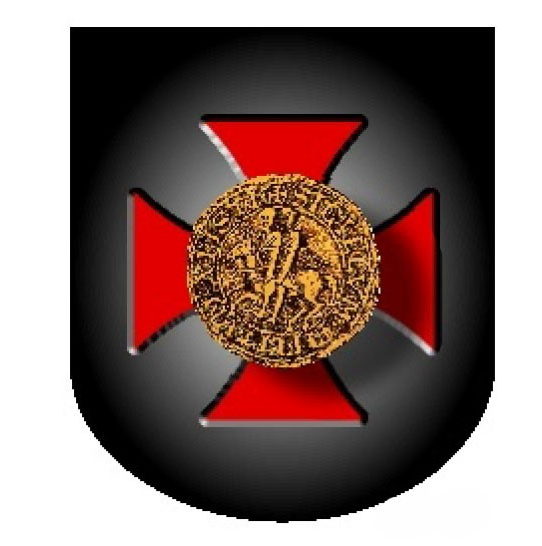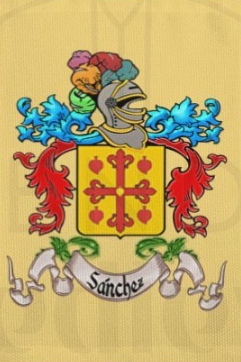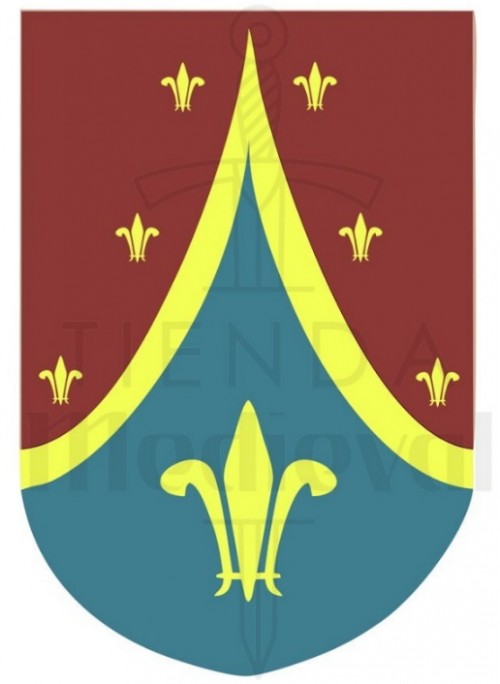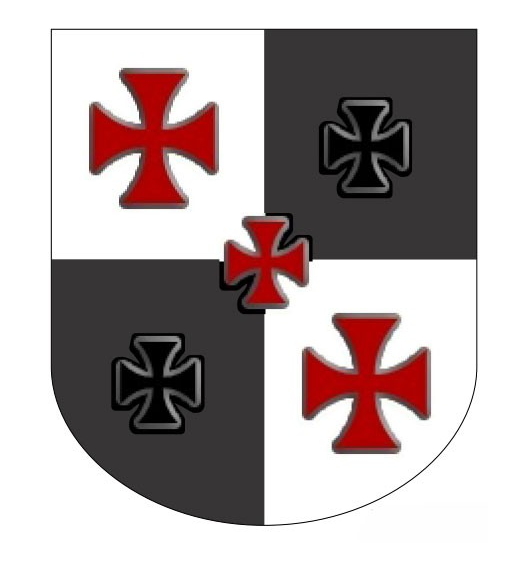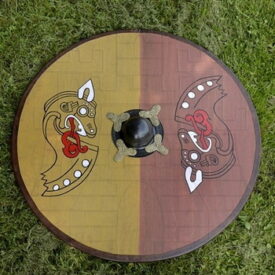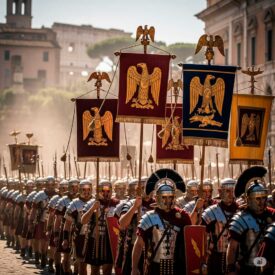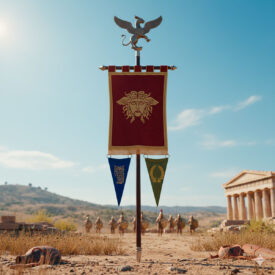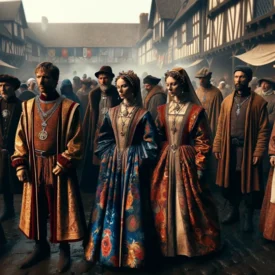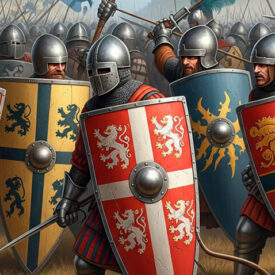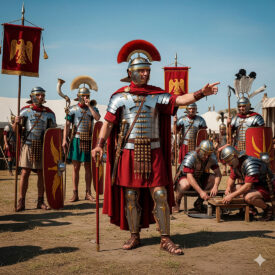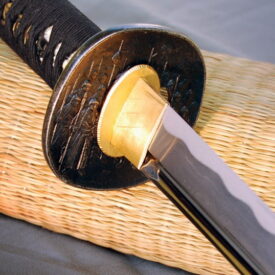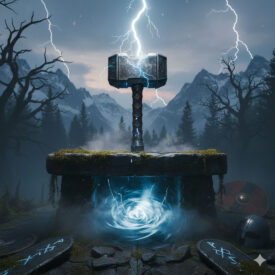Imagine a medieval battlefield: the clash of swords, the clamor of warriors, and, rising above it all, the vibrant fabrics waving in the wind. Standards and banners were much more than mere adornments; they were the heart of military identity, vital reference points, and symbols laden with meaning in an era of constant conflict and deep social hierarchies. From the earliest wooden and earth fortifications to the imposing stone fortresses, medieval castles were symbols of wealth and power, as well as strategic defensive locations. And within their context, medieval flags and standards, with their colors and coats of arms, were irreplaceable elements in military and civilian life.
Join us on this journey to discover the fascinating world of medieval standards and banners, their profound historical relevance, and how their legacy endures to this day.
What exactly were medieval standards and banners?
Although the terms “flag” and “standard” are often used interchangeably today, in the medieval and vexillological context (the discipline that studies flags), they can have significant nuances. Generally, military flags have been used since ancient times to identify units and transmit orders on the battlefield, being a constant element in the strategy and morale of troops.
The word “standard” itself means “stand firm,” an etymology that already gives us a clue to its unwavering purpose. The Royal Spanish Academy (RAE) defines it, from a military point of view, as the insignia used by mounted corps, consisting of a square piece of cloth hanging from a pole, on which the national coat of arms and the arms of the corps to which it belongs are embroidered or superimposed. Formerly, the standard was also used in the infantry, demonstrating its versatility and omnipresence in the military formations of the time.
A “standard” could refer to a wide range of insignias, from any type of flag to a “standard of arms” (a flag that was a square or rectangular version of a coat of arms, directly reflecting the heraldry of its bearer). It could also be a flag for a specific military group or royal standards, which represented the authority and power of the monarch. In a broader sense, a standard is a piece of cloth, often rectangular, held horizontally on a vertical pole, used to identify a group in civil and religious acts, which underlines its importance beyond the military sphere.
Standards in the civil and religious sphere: Beyond the battlefield
Although their role in the military field is the best known, standards also had a vibrant life outside of war. Their use extended to other areas, consolidating themselves as symbols of identity and social cohesion. Today, military flags are used in ceremonies and parades as symbols of pride, perpetuating an ancient tradition.
- Medieval Guilds: These professional and welfare associations used them as their own distinctive in civil and religious acts, such as patron saint festivals, parades, and processions, especially prominent in Corpus Christi celebrations. Each guild proudly displayed its standard, which often incorporated symbols of its trade, demonstrating its unity and its place in society.
- Brotherhoods and Confraternities: These religious organizations adopted many ceremonial functions, carrying richly decorated standards with emblems or iconographic themes alluding to their brotherhood. These standards were and continue to be pieces of textile art, narrating stories of faith and devotion through their embroideries and designs.
Religious communities and brotherhoods use them by painting or embroidering the image, insignia, or anagram of their community or brotherhood. It is secured to a rod or strip across its entire width and hangs from a pole that forms a cross with it, which gives them an imposing presence in any procession or event.
Standards in royalty and as modern decoration
It was also defined as a flag that was hoisted to the main mast of the ship in which a royal person embarked, or to a pole in the building where they were staying, marking the presence of royal authority. These royal standards were often large and made with the most luxurious materials, reflecting the magnificence of the monarchy.
In general, a standard is a type of flag used in different areas, which has transcended its original function to become a decorative element of great impact. Standards offer great attractiveness and elegance and adorn all medieval festivals celebrated in Spain, beautifully decorating balconies, houses, buildings, streets, squares, etc., transporting spectators to a bygone era of knights and castles.
Many restaurants and bars with medieval-style decor add a touch of distinction and sobriety, hanging beautiful standards that provide great luminosity and color, creating very cheerful and at the same time solemn atmospheres. These decorative elements not only evoke the medieval atmosphere but also add a touch of authenticity and character to the spaces.
Stately homes decorate their rooms and hallways with beautiful standards; the same is done by family homes and hotels, because they turn out to be attractive decorative elements of great prominence and beauty. Their presence can transform a space, adding an air of nobility and a link to history.
Beyond a piece of cloth: Its purpose on the battlefield
In the Middle Ages, standards had crucial roles on the battlefield, and their importance cannot be underestimated. They were vital tools for communication, organization, and troop morale. They served primarily as:
- Unit identification: Each army, each feudal lord, each mercenary company had its own unique traditions and designs to identify its units. This was fundamental in the chaos of battle to distinguish allies from enemies and for soldiers to locate themselves within their own formation.
- Order transmission: They were visual tools to communicate instructions to troops over long distances. A specific movement of the standard, its raising or lowering, could mean a charge, a retreat, or a change of formation, allowing vital coordination in a time without radios or modern communications.
- Reference points: They marked the position of commanders and served as vital rallying points for dispersed troops. Amidst the confusion and smoke of battle, seeing their standard waving meant that their leader was still standing and that there was a point to head to regroup.
- Symbols of honor and cohesion: They represented the honor, bravery, and identity of a military unit, fostering pride and unity among combatants. Losing a standard in battle was an immense dishonor, while capturing the enemy standard was a significant victory, both moral and strategic.
The Templars, for example, had specific and extremely rigorous rules for handling their standards in battle, emphasizing the importance of their proper care and presentation. Their standard, the Beauséant, was a sacred symbol that should never fall, and its defense was an absolute priority for the order.
The key figure: The Standard Bearer
Being a standard-bearer was an immense honor, reserved only for trusted knights, with great skill and, above all, unwavering bravery. It was a position of prestige that carried enormous responsibility. However, this task came with an inherent paradox: the standard-bearer, despite his prominent position and vital importance, could not actively participate in combat, as his main function was to keep the standard upright and visible at all times. His weapon was the presence of the standard, not the sword.
Carrying a large standard on horseback was a considerable challenge, even without the pressure of combat. Modern experiments have shown that even with a light breeze, a deployed 5.5-meter long standard could wrap around the rider and horse, an embarrassing and dangerous mishap in battle. Therefore, standards were rolled up (“enrollar”) for transport and unfurled (“desenrollar”) shortly before the attack, signaling readiness for combat and the imminent charge. This act of unfurling the standard was a powerful visual signal for the troops and a challenge to the enemy.
Standard-bearers were preferred targets of the enemy due to their prominent position and limited ability to defend themselves. They were key figures whose fall could demoralize an entire army. Under no circumstances could they drop the standard; this would be considered a loss of honor and an insurmountable shame for the unit and for the standard-bearer himself. Defending the standard with one’s own life was an unwritten oath.
Design and Symbolism: A visual language
The colors and emblems on medieval flags often had specific meanings, often rooted in heraldry and tradition. Each design was a visual statement, a coded language that conveyed identity, loyalty, and purpose. Standards, especially those of arms, displayed the heraldic coats of arms of their owners, often with mottos and insignias representing the values or history of a lineage or institution.
A notable example is the Templar flag, which was divided into two equal parts, one black and one white, with a central element. This design, known as the Beauséant, symbolized the duality of the order: purity and innocence for its friends, and darkness and ferocity for its enemies. This design and other coats of arms were displayed in all their splendor just before the attack, after having been kept rolled up, maximizing their psychological impact. Heraldry and vexillology are closely linked, as formerly it was heraldry that studied flags, vexillology being a more recent and specialized discipline.
The heraldic legacy and the personalization of standards
There is a great variety of medieval-style standards, there are also standard types and there are many more styles of standards that each one can personalize with the images and colors desired. This ability to personalize has been a constant throughout history, allowing each group or individual to express their identity in a unique way.
Many families also have standards with the heraldic coat of arms of their surname. This is a direct link to medieval tradition, where coats of arms were symbols of lineage and belonging. We know that in Spain almost all surnames have heraldic coats of arms and that is why it is easy for all of us to make our own family standard with our surnames, thus connecting with our historical roots.
If you wish to search for your surname with its respective heraldic shield, you can easily find it and have it printed on your personalized standard whenever you want, creating a unique piece that celebrates your heritage. This is a wonderful way to keep the heraldic tradition alive in the 21st century.
You can also personalize your cape and/or your medieval costume with a beautiful and colorful print of your surname’s heraldic shield and/or have your quartered medieval cape or costume made when you acquire it. Imagine attending a medieval fair or a themed event wearing your own family crest, a detail that will undoubtedly make you stand out and connect you even more with history.
Vexillology: The science behind standards
The word “vexillology” itself, which is the study of flags, pennants, and standards, comes from the Latin vexillum, meaning ‘standard’ or ‘flag’, and the Greek logos, ‘knowledge’. It was Dr. Whitney Smith who coined the term in 1957 for this auxiliary discipline of history, recognizing the need for a field of study dedicated exclusively to these important insignias.
Vexillology is the auxiliary discipline of history dedicated to the study of flags, pennants, and standards. A specialist in this area is known as a vexillologist. This field studies the historical development, design, and symbols of flags, examines customs on how to hoist them, and generates knowledge about the identity of a nation, an institution, or a social group. It is a fascinating field that combines history, art, and semiotics.
Vexillologists investigate historical records to understand the symbols of flags, their origins, the ideals encapsulated in their designs, and their evolution over time. They also delve into semiotics, the study of signs and symbols, to unravel the hidden messages and visual narratives that flags have conveyed throughout the centuries. From battle flags to ceremonial insignias, each piece of cloth is a historical document waiting to be interpreted.
A legacy that endures
From the earliest wooden and earth fortifications to the imposing stone fortresses, medieval castles were symbols of wealth and power, as well as strategic defensive locations. From the 15th century onwards, as castle warfare declined, the imposing towers and battlements became recognizable symbols of power, even being added to large country houses or peaceful buildings such as churches and universities. Similarly, standards transformed into powerful symbols beyond their purely military function, adapting to new contexts and maintaining their relevance.
Medieval flags and standards, with their vibrant colors and intricate coats of arms, were irreplaceable elements in the military and civilian life of the Middle Ages. Their history, from the art of rolling and unrolling them on the battlefield to the unwavering courage of the standard-bearers, allows us to glimpse the importance these waving fabrics had in the society of the time. They were more than mere objects; they were the soul of armies, the identity of lineages, and the expression of faith.
Even today, the fascination with standards endures, reminding us of a past where a piece of cloth could decide the course of a battle or represent the honor of a lineage. Their beauty, symbolism, and connection to an era of knights and heroic deeds make them pieces of great historical and decorative value. If you are passionate about medieval history and wish to add a touch of authenticity and elegance to your home or event, we invite you to browse our section of medieval and historical standards so that you will be amazed by such variety and good design. Discover the perfect standard that captures the essence of chivalry and medieval honor.

